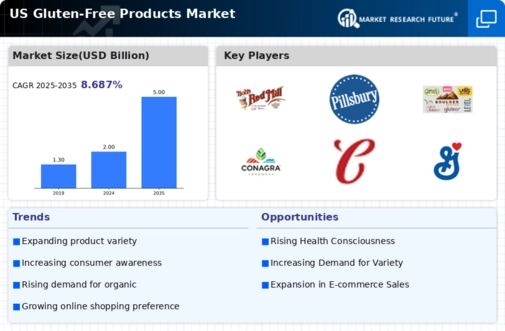Shifts in Dietary Preferences
The gluten free-products market is experiencing a notable shift in dietary preferences among consumers. Many individuals are adopting gluten free diets for perceived health benefits, including improved digestion and increased energy levels. This trend is not limited to those with gluten sensitivities; a significant portion of the population is opting for gluten free products as part of a broader health-conscious lifestyle. In fact, surveys indicate that nearly 30% of consumers in the US are actively seeking gluten free options. This shift is prompting manufacturers within the gluten free-products market to innovate and diversify their offerings, ensuring that they meet the evolving demands of health-oriented consumers.
Rising Awareness of Celiac Disease
The increasing awareness of celiac disease and gluten intolerance is a pivotal driver for the gluten free-products market. As more individuals are diagnosed with celiac disease, which affects approximately 1 in 100 people in the US, the demand for gluten free options has surged. This heightened awareness has led to a significant shift in consumer preferences, with many seeking gluten free alternatives even if they do not have a medical diagnosis. The gluten free-products market is responding to this trend by expanding product lines to cater to this growing demographic. In 2025, the market is projected to reach a valuation of over $5 billion, indicating a robust growth trajectory fueled by increased consumer education and awareness.
Increased Availability in Retail Channels
The gluten free-products market is benefiting from increased availability across various retail channels. Supermarkets, health food stores, and online platforms are expanding their gluten free product selections, making it easier for consumers to access these items. In 2025, it is estimated that over 70% of grocery stores in the US will carry dedicated gluten free sections, reflecting a significant commitment to meeting consumer demand. This enhanced accessibility is crucial for the gluten free-products market, as it allows consumers to make informed choices and encourages trial among those who may be hesitant to switch to gluten free options. The proliferation of gluten free products in mainstream retail is likely to further drive market growth.
Influence of Social Media and Influencers
The gluten free-products market is increasingly influenced by social media and health influencers who promote gluten free lifestyles. Platforms such as Instagram and TikTok have become vital channels for sharing recipes, product reviews, and personal experiences related to gluten free diets. This trend has the potential to shape consumer perceptions and drive demand for gluten free products. In 2025, it is projected that social media marketing will account for a significant portion of advertising expenditures within the gluten free-products market. As influencers continue to advocate for gluten free living, they are likely to attract new consumers and reinforce the choices of existing ones, thereby contributing to market expansion.
Regulatory Support for Gluten Free Labeling
Regulatory support for gluten free labeling is a critical driver for the gluten free-products market. The US Food and Drug Administration (FDA) has established clear guidelines for gluten free labeling, which helps consumers make informed choices. This regulatory framework not only protects consumers but also encourages manufacturers to produce gluten free products that meet these standards. As of 2025, compliance with gluten free labeling regulations is expected to be a key factor in product development within the gluten free-products market. This regulatory clarity fosters consumer trust and confidence, ultimately driving sales and market growth as more individuals seek out certified gluten free options.



















Leave a Comment